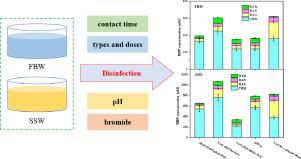Water Research ( IF 11.4 ) Pub Date : 2021-02-23 , DOI: 10.1016/j.watres.2021.116964 Yunkun Qian , Yanan Chen , Yue Hu , David Hanigan , Paul Westerhoff , Dong An

|
Drinking water treatment plants (DWTPs) produce filter backwash water (FBW) and sedimentation sludge water (SSW) that may be partially recycled to the head of DWTPs. The impacts of key disinfection conditions, water quality parameters (e.g., disinfection times, disinfectant types and doses, and pH values), and bromide concentration on controlling the formation of trihalomethanes (THMs), haloacetic acids (HAAs), haloacetonitriles (HANs), and haloacetamides (HAMs) during disinfection of FBW and SSW were investigated. Concentrations of most disinfection byproducts (DBPs) and associated calculated toxicity increased with extended chlorination for both FBW and SSW. During chlorination of both FBW and SSW, elevated chlorine doses significantly increased THM yields per unit dissolved organic carbon (DOC), but decreased HAN and HAM yields, with minimum effect on HAA yields. Chloramine disinfection effectively inhibited C-DBP formation but promoted N-DBPs yields, which increased with chloramine dose. Calculated toxicities after chloramination increased with chloramine dose, which was opposite to the trend found after free chlorine addition. An examination of pH effects demonstrated that C-DBPs were more readily generated at alkaline pH (pH=8), while acidic conditions (pH=6) favored N-DBP formation. Total DBP concentrations increased at higher pH levels, but calculated DBP toxicity deceased due to lower HAN and HAM concentrations. Addition of bromide markedly increased bromo-THM and bromo-HAN formation, which are more cytotoxic than chlorinated analogues, but had little impact on the formation of HAAs and HAMs. Bromide incorporation factors (BIFs) for THMs and HANs from both water samples all significantly increased as bromide concentrations increased. Overall, high bromide concentrations increased the calculated toxicity values in FBW and SSW after chlorination. Therefore, while currently challenging, technologies capable of removing bromide should be explored as part of a strategy towards controlling cumulative toxicity burden (i.e., hazard) while simultaneously lowering individual DBP concentrations (i.e., exposure) to manage DBP risks in drinking water.
中文翻译:

饮用水处理中过滤反冲洗和沉淀污泥水消毒过程中C-和N-DBP的形成和控制
饮用水处理厂(DWTP)产生的过滤器反冲洗水(FBW)和沉淀污泥水(SSW)可能会部分回收到DWTP的顶部。关键消毒条件,水质参数(例如消毒时间,消毒剂类型和剂量以及pH值)和溴化物浓度对控制三卤甲烷(THM),卤乙酸(HAAs),卤乙腈(HANs)的形成的影响,研究了FBW和SSW消毒过程中的卤代乙酰胺(HAMs)。对于FBW和SSW来说,大多数消毒副产物(DBPs)的浓度和相关的计算毒性都随着氯化时间的延长而增加。在FBW和SSW氯化过程中,增加氯剂量会显着提高每单位溶解有机碳(DOC)的THM产量,但会降低HAN和HAM产量,对HAA产量的影响最小。氯胺消毒可有效抑制C-DBP的形成,但可提高N-DBP的产量,并随氯胺剂量的增加而增加。氯化胺处理后的计算毒性随氯胺剂量的增加而增加,这与添加游离氯后发现的趋势相反。pH值影响的检查表明,在碱性pH值(pH = 8)下更容易生成C-DBP,而在酸性条件(pH = 6)下有利于N-DBP的形成。在较高的pH值下,总DBP浓度会增加,但由于HAN和HAM浓度较低,因此计算出的DBP毒性降低了。溴化物的添加显着增加了溴代THM和溴代HAN的形成,它们比氯化类似物具有更高的细胞毒性,但对HAAs和HAM的形成几乎没有影响。随着溴化物浓度的增加,两种水样中THM和HAN的溴化物掺入因子(BIF)均显着增加。总体而言,较高的溴化物浓度会增加氯化后FBW和SSW中计算出的毒性值。因此,尽管当前具有挑战性,但应探索能够去除溴化物的技术,以作为控制累积毒性负担(即危害),同时降低单个DBP浓度(即暴露)以管理饮用水中DBP风险的策略的一部分。











































 京公网安备 11010802027423号
京公网安备 11010802027423号